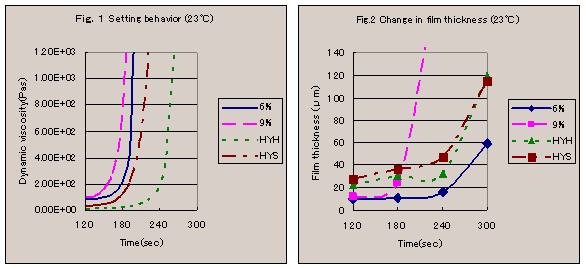ABSTRACT: 0991
Setting Behavior of New Ion-releasing Temporary Cement Containing S-PRG filler
| S. TAKANO, H. TACHIDOKORO, T. NAKATSUKA, M. DEGUCHI, and N. NEGORO, Shofu Inc, Kyoto, Japan | |
Objectives: In recent years, S-PRG filler (S-filler) has been reported to have characteristics including acid-buffering capacity, dentin remineralization and acid-resistant layer-forming ability induced by effects of various ions released from S-filler. This study aimed to evaluate setting behavior and change in film thickness of a new ion-releasing temporary cement (SI-R20503:SI) containing S-filler. Methods: Materials used were: SI consisting of ZnO-based powder containing S-filler (6%, 9%) and liquid containing polycarboxylic acid salt; and HY-Bond Temporary Cement (Hard:HYH, Soft:HYS) as a control. The powder and liquid were mixed with the standard P/L ratio of 1.8 for SI (1.6 for HYH, 2.2 for HYS) for approx. 30s. At 2min after the start of mixing and onward, each cement was measured for its dynamic viscosity (DV) using a dynamic viscoelasticity measuring instrument (JASCO International co.,Ltd) and film thickness (FT) according to ISO9917 to evaluate setting behavior and change in FT over time. Results: After mixing, SI showed less change in DV for a certain period, followed by a sudden DV increase proportional to the S-filler content, whereas the control exhibited gradual DV change for both HYH and HYS. Compared to the control, SI maintained thinner FT up to 180sec after the start of mixing, and then exhibited different behavior changes in FT depending on the S-filler content: the higher the S-filler content was, the more dramatically FT increased. Conclusion: The dramatic increase in DV and FT for SI was considered to be due to the release of cations from S-filler and the acid-base reaction facilitated by the mixing of S-filler-containing powder and acidic liquid. It is suggested that adjustment of S-filler content in powder enables control of working time and setting properties to provide clinically-effective handling properties for SI.
| |
| Seq #108 - Resin Cement Mechanical Properties, Glass Iomoners 3:30 PM-4:45 PM, Thursday, July 3, 2008 Metro Toronto Convention Centre Exhibit Hall D-E | |
|
Back to the Dental Materials 3: Ceramic-based Materials and Cements Program | |
©Copyright 2008 American Association for Dental Research. All Rights Reserved.
